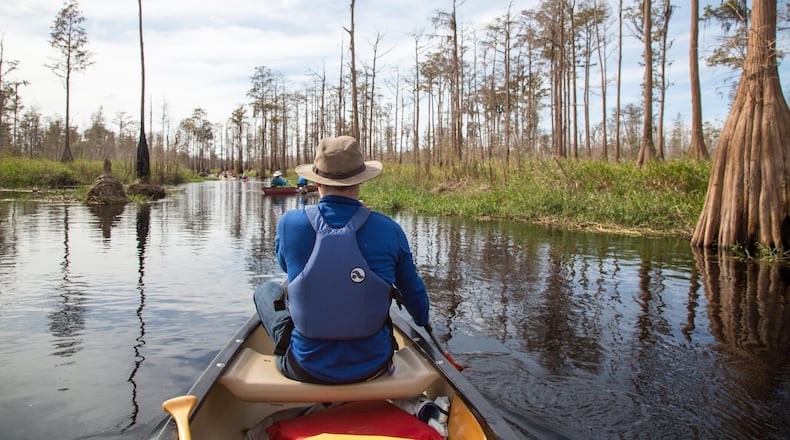A new report released Tuesday says South Georgia’s famed Okefenokee Swamp is among the most endangered waterways in the country because of a proposed titanium mine planned less than three miles from the swamp’s edge.
The report from the nonprofit American Rivers titled “America’s Most Endangered Rivers” is released annually to highlight the waterways across the country most imperiled by pollution, development, dams and more.
The organization says rivers are placed on the list based on their biodiversity, the level of risk they face and whether a decision that could affect the fate of the river is looming. The Okefenokee, which sits at the headwaters of the St. Marys and Suwannee Rivers, checked all of those boxes, the group said.
The Okefenokee is making its second appearance on the “most endangered” list — it was listed previously in 2020 because of the same mining project.
“The Okefenokee is on this list again because of the fundamental threat posed by the plans to mine the sand deposits along the edge of the swamp,” said Ben Emanuel, Southeast Conservation Director with American Rivers.
The swamp contains the Okefenokee National Wildlife Refuge, the largest such preserve east of the Mississippi River. It is home to thousands of species of plants, birds, reptiles and mammals, including some classified as threatened and endangered. The refuge also contains millions of tons of peat deposits, preventing huge amounts of heat-trapping gases from escaping into the atmosphere.
An Alabama-based company called Twin Pines Minerals is seeking to strip mine for titanium on Trail Ridge, the ancient inland sand dune complex that forms the eastern border of the swamp.
Titanium is used in aircraft and defense systems, but its most common use is in titanium dioxide, a whitening agent found in toothpaste, sunscreen, paint and other household products.
The company and regulators at the Georgia Environmental Protection Division (EPD) insist the planned 580-acre mine won’t lower water levels in the swamp or harm wildlife.
In a statement, Twin Pines president Steve Ingle called the Okefenokee’s inclusion on the list “a publicity stunt and a last-ditch attempt to influence EPD by opponents who know they cannot win on the merits.”
“The facts and science are on our side and show that our project poses no risk to the Okefenokee Swamp,” he added.
But federal officials, hydrologists and environmentalists disagree, warning the project could irreparably damage one of the country’s ecological gems — and a critical driver of tourism for the region.
“For the Okefenokee, mining that would harm the swamp is bad for business,” said Rena Ann Peck, the executive director of the Georgia River Network. Roughly 600,000 tourists visit the swamp each year and pump an estimated $65 million into the local economy.
Approval of the company’s plans has been juggled between federal and state authorities, with the permitting decisions ultimately landing in the hands of Georgia EPD last year.
In January, EPD released the company’s draft mining land use plan. During the two-month open comment period that followed, the agency received more than 77,000 comments on the plan from members of the public.
EPD spokeswoman Sara Lips said the agency is still reviewing technical comments it received. When that is finished, the agency will determine whether changes to the company’s mining plans are needed. From there, the agency could issue draft permits to the project, but Lips said there is no estimate for when the review will be complete.
American Rivers called on EPD to deny the permits.
“Some places are simply too special and should be off-limits to pollution and harmful development,” said Ben Emanuel. “The Okefenokee Swamp is one of those places.”
Other bodies of water on the 2023 “most endangered” list include the Colorado River, where a climate change-fueled megadrought has sent water levels plummeting, and the Ohio River, a critical water supply threatened by industrial pollution.
A note of disclosure
This coverage is supported by a partnership with 1Earth Fund, the Kendeda Fund and Journalism Funding Partners. You can learn more and support our climate reporting by donating at https://www.ajc.com/donate/climate/
About the Author
Keep Reading
The Latest
Featured


